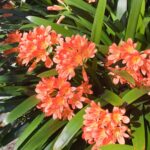Some of the unforgettable things which were popular in the 1970’s were shag pile carpet, the bean bag and the pop group, Abba. One popular indoor plant of the seventies was the Chinese Happy Plant, Dracaena fragrans ‘Massangeana’ also known as the Chinese Money Tree, a variegated plant that sprouts from a piece of apparently dead wood. Happy Plants are extremely hardy and many have survived from the seventies until today. They had become very unfashionable but are set to make a comeback in a somewhat different form.
The new way to grow Happy Plants is with the leafy crown on top of a straight, architecturally strong trunk which looks something like an elephant’s leg. The trend is towards solid green foliage rather than variegated leaves with central yellow stripes, or silver streaks and yellow edges.
How to pot Happy Plants
On Burke’s Backyard, we demonstrated how to make a group of Happy Plants look attractive by repotting them in green glazed Vietnamese pots.
1. The Vietnamese pots we purchased were manufactured without saucers thus we were forced to put our happy plants into plastic ‘inner’ pots and saucers to be placed inside the ceramic pots.
2. Put a small amount of potting mix in the bottom of the pot before trying the plant out for size.
3. Take the plant out of its existing pot and place it in the new inner pot. Be careful when repotting Happy Plants as the top of the plant is very heavy – if it were to fall over it would damage the roots. Because of the striking shape of the plant, it is critical that each plant should be accurately placed in the centre of the pot. Step back and take a few sightings to make sure the plant is vertical.
4. Once the plant is in the pot in the right position, pack some more potting mix down around the existing root ball. This step would not normally be carried out when repotting a plant, but as the top of the Happy Plant is very heavy, the potting mix needs to be sufficiently pushed down to give the plant some form of anchorage.
5. When we bought our inner pots, great care was taken to select both pots and saucers which fitted exactly inside the outer ceramic pots. Dress around the top of each pot with sphagnum moss. If the plastic pots are visible the whole effect can be ruined. Next, put the plastic inner pots inside the decorative ceramic pots. The foliage on top of the plants used would eventually double or triple in size.
The resulting arrangement was very striking and would blend in well with modern Mediterranean or Santa Fe decor.
Care
Happy Plants prefer partial shade and out of direct heat of the sun and draughts. They like good drainage and allow to dry out between watering. Wet feet will cause root rot. Keep leaves clean with a gentle wipe-over as this will also help to prevent Mealybug.
Cost and availability
Although an arrangement of three Happy Plants such as these would not be cheap, they would constitute value for money. Shopping carefully, the largest plant (100cm tall) could be purchased for around $40, the middle-sized one for around $20 and the smaller one for around $16. The nest of three Vietnamese pots would cost around $110. The cost of the whole arrangement, including sphagnum moss at the base of each plant to make it look attractive, would be around $220.



